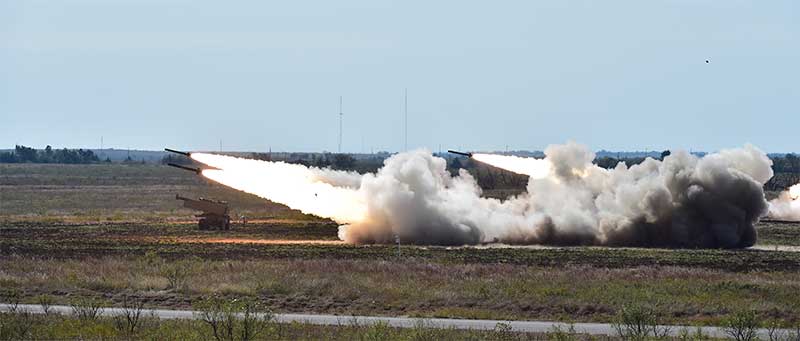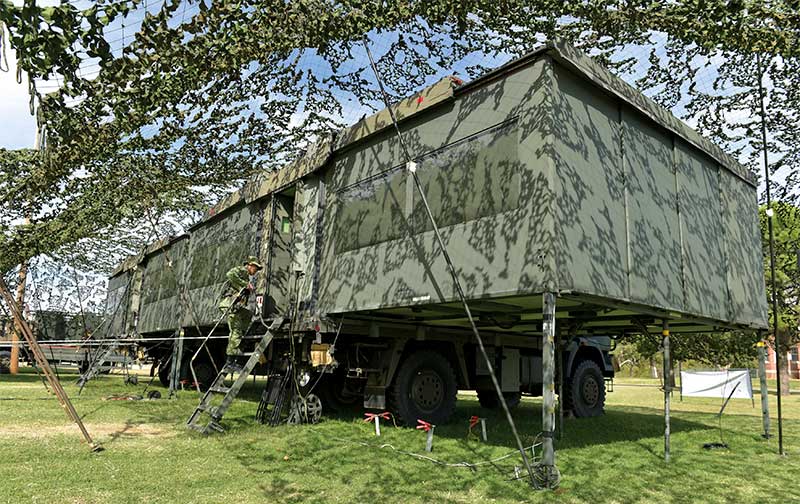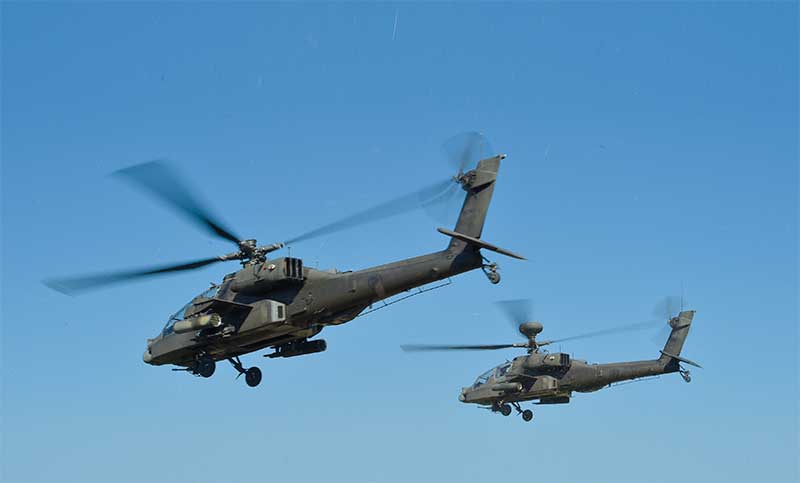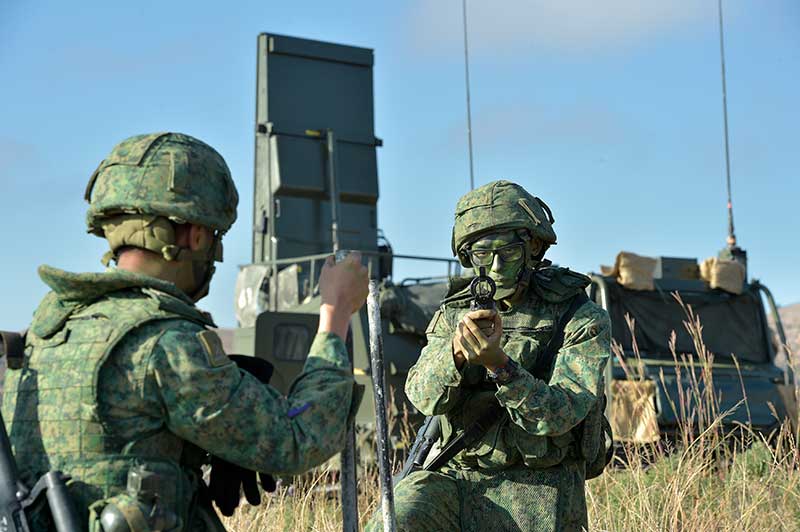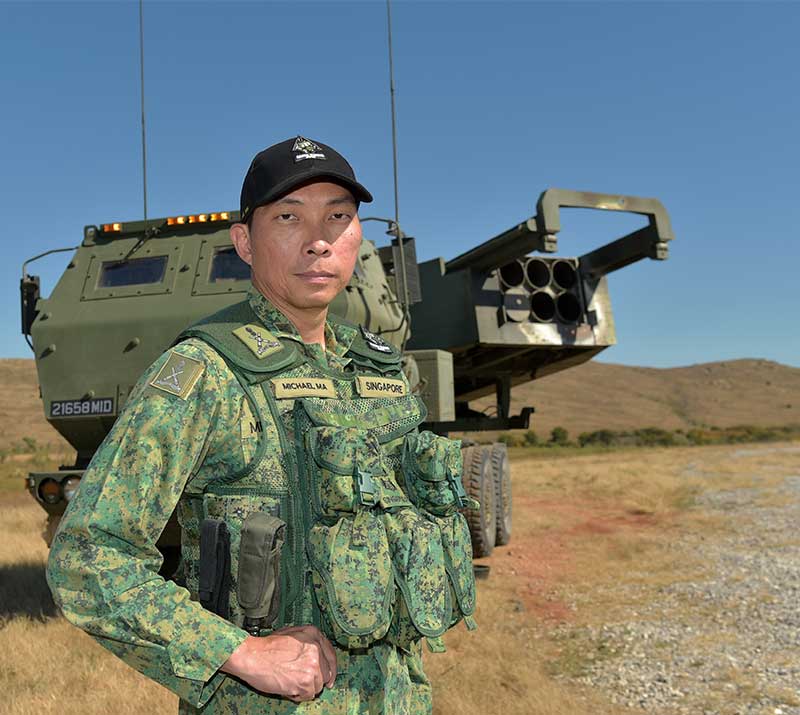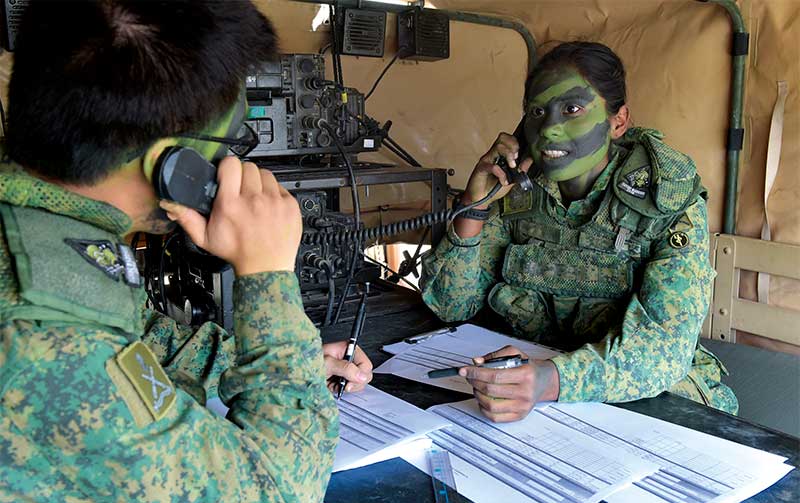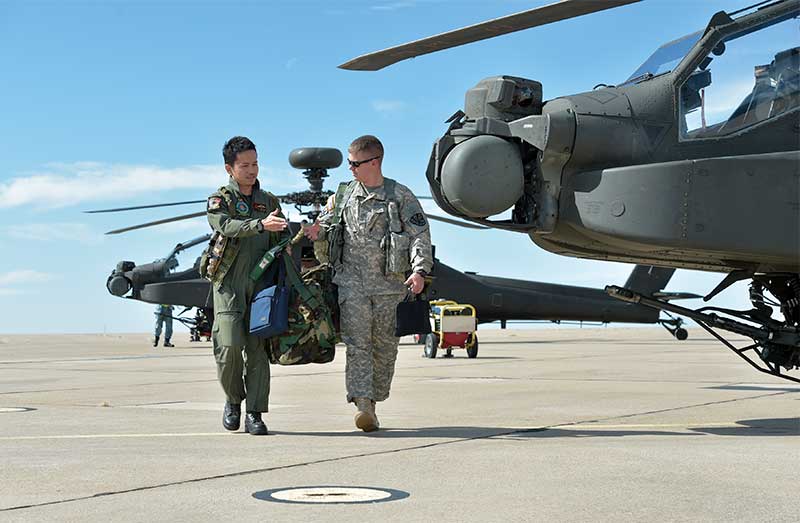OPS & TRAINING
DARING STRIKES, WARRIOR HEARTS
12 Dec 2016
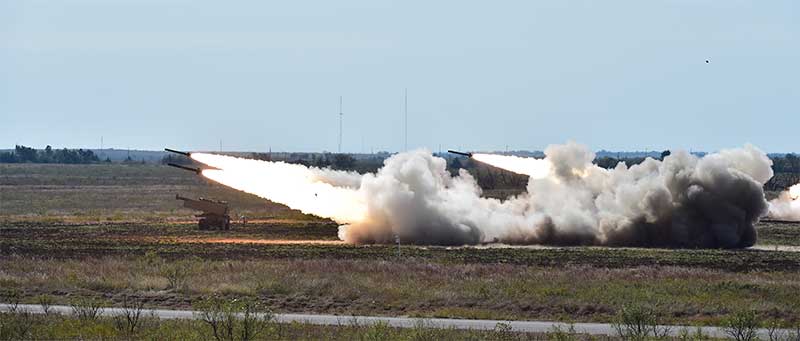
It was a seamless effort as the SAF's and the US Army's High Mobility Artillery Rocket System (HIMARS) launchers worked hand-in-hand to take out the targets.
Meanwhile, two Republic of Singapore Air Force (RSAF) AH-64D Apache attack helicopters already on scene rained fire on the same targets. The enemy never stood a chance.
This air-land integrated live firing was part of Exercise Daring Warrior, a large-scale bilateral exercise held from 10 to 31 Oct at Fort Sill, Oklahoma. About 340 SAF personnel and 140 troops from the US were involved in the exercise.
The assets deployed included the HIMARS and the Artillery Hunting Radar (ARTHUR) from the Singapore Army, and Apache attack helicopters from the RSAF's Peace Vanguard detachment. The US assets hailed from the US Army's 75th Field Artillery Brigade and the National Guard.
Tight ties
Calling the bilateral strike an unprecedented move, then-Senior Minister of State for Defence Ong Ye Kung, who witnessed it on 28 Oct, said: "Today we fired six rounds - three from the US forces and three from us. This is unprecedented. It shows the tight ties we have operationally (and) the cooperation at a broad level between the US and Singapore armed forces."
Mr Ong added that the integration of various assets - from the Commandos to the Apache attack helicopters - showcased the SAF's ability to operate as an effective system in a complex environment. He also noted that the tight integration between the Army and the RSAF was a reflection of the complexity of modern warfare today.
Colonel (COL) Stephen Maranian, Commandant of the US Field Artillery School, also highlighted the value of Exercise Daring Warrior.
Referring to the SAF as a great partner, he said: "Exercise Daring Warrior has been ongoing for six years, and our nations have worked together very closely. The three launchers from Singapore and the three launchers from the US firing simultaneously and having tremendous impact (is) proof of what partnership and interoperability can do when you work closely."
Heart of operations
Aside from the live-firing components, the large-scale exercise was a test of teamwork among the various units, including the Commandos, the STrike ObserveR Mission (STORM), HIMARS and ARTHUR teams, and coordinators at the Division Strike Centre (DSC). Functioning as both a command post and a headquarters, the DSC was made up of personnel who coordinated the whole mission, from detecting and tracking targets to calling for the attacks.
Commenting on the complexity of their roles, Exercise Director and Chief Artillery Officer COL Michael Ma said: "It's challenging as they do not know where the enemy is, and they do not know when the enemy will show itself.
"And when the enemy does show itself, they have to coordinate and integrate various assets like the Apaches, HIMARS and STORM teams on the ground to ensure the whole process is executed seamlessly in a matter of minutes."
All-rounded training
Comprising troops from the 6th Singapore Division, this year's DSC was largely made up of Operationally Ready National Servicemen (NSmen).
Captain (CPT) (NS) Bryan Lim, Head Targeting Management Team in the DSC, admitted that operating in it was both challenging and stressful. His team had to constantly analyse if the target was the right one to engage, weigh decisions and calculate the time required for the ammunitions to hit the target.
"Each mission required a lot of coordination between different assets and units, and time is always against us when it comes to engaging the targets," explained CPT (NS) Lim, who works in the IT department at the Monetary Authority of Singapore. "Just as you think you've settled one mission, another one comes along. Sometimes we don't even have time for toilet breaks!" To keep them on their toes, personnel in the DSC received an average of 15 missions a day and their complexity grew with each new mission. The highest number they clocked in one day? A whopping 33 missions.
Nevertheless, the 31-year-old was unfazed by the long hours and intensity of the missions. From communicating with the Apache pilots to coordinating with the ground troops and calling for fire, he felt that the exercise provided him with great all-rounded training.
"Coming here and seeing the realism of the exercise, you can't help feeling the excitement. This not only hones our skills, but also helps us ensure that we are clear in our processes for future call-ups," said CPT (NS) Lim.
"It's a unique experience you can't replicate anywhere else."
Into enemy grounds
When it comes to being the eyes of the SAF, the ARTHUR and the STORM teams take on different roles. The former aids in tracking enemy artillery rounds to locate where their guns are while the latter seeks out the enemy and calls for fire.
ARTHUR locator Lance Corporal (LCP) Gideon Lim explained that, apart from tracking enemy rounds, the weapon locating radar also has the ability to track projectiles, such as artillery rounds and rockets, shot from friendly HIMARS units at a distance of up to 40km.
"In operations, we track impact of fire with the radar and act as the eyes of the guns. After we track the rounds, we can locate where the enemy guns are and feed the information to the gun side."
The 21-year-old from 24th Battalion, Singapore Artillery (24 SA) added that, based on the information that the radar collects, they would communicate to the HIMARS the adjustments needed for more accurate shooting.
For 2nd Sergeant (2SG) Eric Peh, being part of the STORM team was an exciting experience as it involved studying the enemies and coordinating both air and land fires.
Once the mission is received, STORM teams are inserted in advance to observe enemy movements. Working in two-man teams, they would set up observation posts to watch for the enemy.
"There's always this feeling of nervousness because we are unsure if we will spot the enemy," said 2SG Peh.
When the enemy appears, the STORM team will send the coordinates to the Apache pilots and the HIMARS unit to carry out the integrated attack. Post-attack, the STORM team would also verify if the rounds have landed on the targets accurately.
Effective communication
Time is of the essence when it comes to calling for an attack, and the STORM teams have to work closely with the Apache pilots to ensure that no mistakes are made.
2SG Peh said: "Before the mission, we will tie down with the Apache pilots on where the target area is, what the terrain is like, what challenges we might face and how to overcome them."
Even so, the 20-year-old from 24 SA admitted that there were challenges in communicating target information to the pilots as they had very different fields of visions of the targets.
While the STORM teams acquired and viewed the target from the footages from the US Army National Guard's Unmanned Aerial Vehicles (UAVs), the pilots looked at the target from a lower altitude. This meant the former always had to imagine the target from the latter's perspective in order to guide him effectively.
Nevertheless, 2SG Peh was very grateful for the pilots' constant patience and understanding. During debriefs, the pilots would show the team their point of view from the aircraft and both sides would compare footage to gain a better understanding of what the other party was seeing.
"The pilots were really helpful. For some of us, it was our first time controlling live-firing, so they saw the training value in this and always guided us along to see how we could improve," he explained. "As the missions went on, we eventually did."
For Apache pilot Major (MAJ) Lim Wei Meng, challenges like these could be overcome through close planning and coordination. The 36-year-old revealed that he was working 12 hours a day from mission briefs and executing the day and night missions, to reviewing them and ironing out perspective and communication issues with the Army. But it was worth the effort.
"The main challenge of integrated strike operations lies in their complexity because you are dealing with many entities. At the end of the whole thing, you just want to see rounds on the target and to achieve that, everyone has to execute his role effectively," he said.
Night strikes
When it came to night missions, more often than not, the pilots took the lead in locating the targets.
Said MAJ Lim: "We have always been operating predominantly in the night environment but the STORM teams are limited by their visibility on the ground.
"Because we can see further and there is only so much information that they can hand over to us, we will communicate even more closely with them to confirm the coordinates of the targets."
To overcome this, 2SG Peh revealed that instead of trying to describe the target, he learnt to use surrounding features to confirm it. Through constant communication, the STORM team would rely on the pilots' guidance for the location of the target before giving the go-ahead for fire.
He said: "Training in such a large terrain and vast open spaces showed us how important the communication was. We really had to share our knowledge with the pilots and vice versa in order to improve each other's skills."
Shoot and scoot
As one of the major players in the exercise, the HIMARS receives commands from the STORM teams and fires accordingly. But it is not that simple.
From the time the HIMARS team receives the call for fire, they have to move to the firing point while processing the target information, laying their launcher and firing - all within minutes. The vehicle will then scoot back into hiding to avoid being detected.
"In those few minutes, it's quite stressful. Your adrenaline's rushing and you need to get things done. You need a lot of coordination and at every layer, everyone needs to trust one another as information is being pumped down," said Lieutenant (LTA) Anithra Sukumar Srimathi.
But in her opinion, the biggest constraints of operating in the exercise were the unfamiliar terrain and the weather. The HIMARS platoon commander from 23 SA explained that her team had to recce the grounds thoroughly in order to determine the deployment and hiding spots for the HIMARS.
It gets more challenging with pitch black skies, especially when they had to drive to the deployment point, fire and hide with tactical lights, and LTA Anithra admitted that they had gotten lost before.
"It's really much tougher. There's blackout drive, and our guys have to be extra careful. We have to keep our command post covered up and talk really softly," said the 25-year-old.
"Night deployments are a challenge, but it's a really good experience for all of us because if you can execute and deploy in time, you're really good."
Trading tactics
Aside from the training, one of the significant takeaways from participating in the bilateral exercise was the opportunity to interact with their US counterparts.
As part of the STORM team, 2SG Peh had the privilege of pairing up with members from the US Fire Support Team (FIST) during enemy stake-outs. He revealed that during such pairings, the FIST would offer the STORM team pointers on making better use of the surroundings at the observation post to camouflage themselves.
Apart from trading personal stories and deployment experiences during the long hours of waiting, 2SG Peh also had the chance to try out his partner's equipment and seek advice on tactics.
MAJ Lim also saw value in interacting with his US counterparts. When it came to mission tie-up and coordination, the pilots from Peace Vanguard's US Army Flight Training Detachment would give their inputs, and tactics were refined.
He said: "Their combat experience is something that Singaporean pilots have not experienced (and) the tactics that they employ, especially in the heat of battle, are very applicable to us."
Different roles, united force
One thing's for sure, the exercise was an eye-opener for many, especially the NSmen and Full-time National Servicemen (NSFs). "It is extremely beneficial to the NSmen as they don't get to see such large air-land integrated live-firing back in Singapore," said COL Ma.
"Witnessing all this allows them to validate their abilities and training. It also gives them tremendous confidence that what they have been training in Singapore is effective."
For 2SG Peh, being able to participate in the exercise was a privilege.
"This makes me appreciate how as NSFs, all of us have a part to play in the defence of our country," he said.
"Even though we have different roles, we're putting our best foot forward and making the most out of this experience so that we can all be better prepared for what challenges we may face in the future."
ALSO READ IN OPS & TRAINING
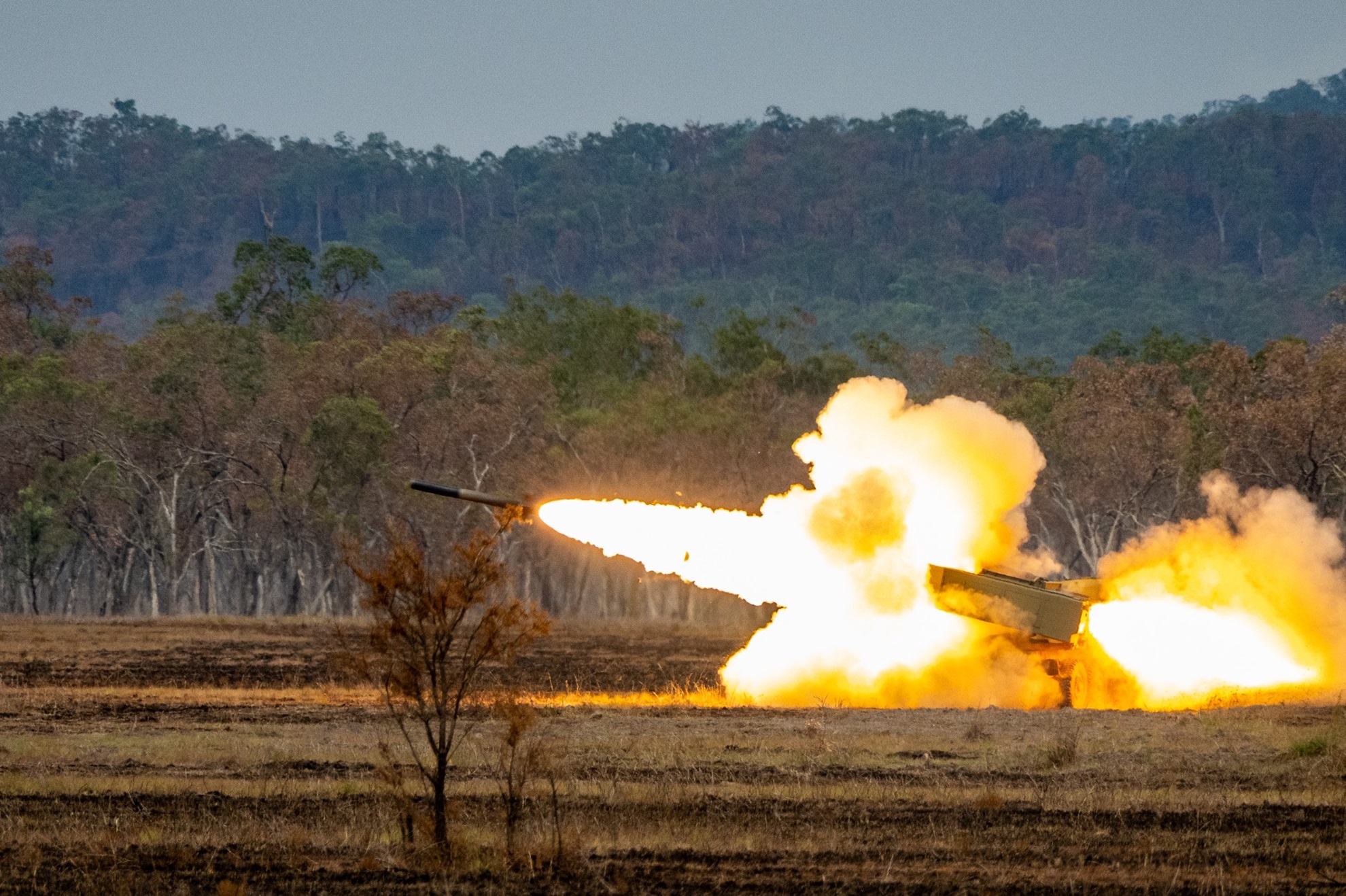
Exercise Wallaby 2025: To see better, shoot faster
31 Oct 2025
The SAF focuses on complex strike missions and multi-domain integration in Exercise Wallaby 2025, the 35th edition of its largest unilateral overseas exercise.
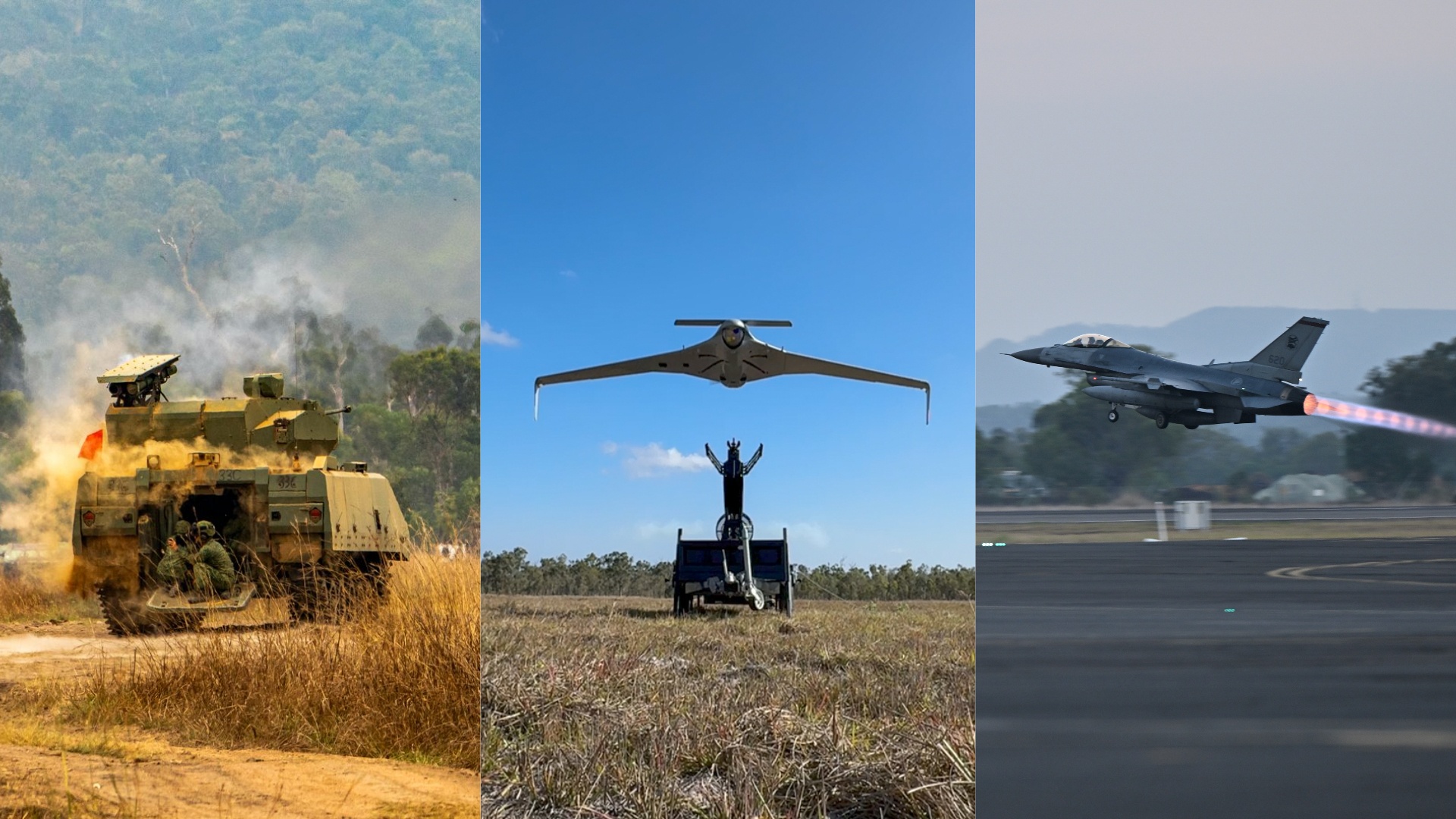
Ex Wallaby 25 – Greater Integration and Complexity
25 Oct 2025
The 35th edition of the SAF’s largest unilateral overseas exercise is an opportunity for expanded scale and deeper integration towards an effective, networked fighting force.

Ex Forging Sabre ramps up use of unmanned assets in integrated strike operations
12 Sep 2025
In this 10th edition of Exercise Forging Sabre, the SAF sharpened its cutting edge for the dynamic modern battlefield, with expanded integration between manned and unmanned platforms.

